 1827
1827 |
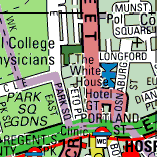 1999
1999 |
The images in this web page are presented as a supplement to essays on the Diorama in Great Britain which first appeared in print in the quarterly journal History of Photography, Autumn 1993 (Vol 17, No.3, pp. 284-295) and on the Diorama in Paris in Photoresearcher (ESHPh), No 6 (1994/95/96), pp.35-40
|
Diorama Patent | more engravings (3.2) | Home Page | |
Part 1.1 : Maps of the Park Square East, Regent’s Park, London, site of the Diorama
 1827
1827 |
 1999
1999 |
Top-left: Greenwood’s Map of London 1827, by courtesy of the Bathspa website
Top-right: click on the 1999 map to go to on-line map of the area on Multimap.com website
Part 1.2 : Map of present day 10e Arrondisement Paris, site of the Diorama
The area of Paris in which the Diorama existed in the 1820s and 1830s later became completely redeveloped. In the 1920s Georges Potonniée investigated the area and established where would have been the site of the Diorama. His sketch map has been reproduced in the essay on ‘Daguerre and his Diorama in the 1830s’. That map can be compared with the locality as it is today in 2001, first in the map (courtesy of Tele Atlas/Multimap.com), the site here pin-pointed on the south side of rue Léon Jouhaux at Caserne Verines just off the north corner of Place de la Republique, and secondly in aerial view (courtesy Geoinformation Group/Google Earth):
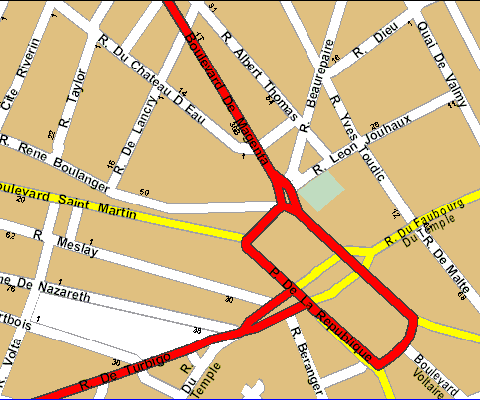
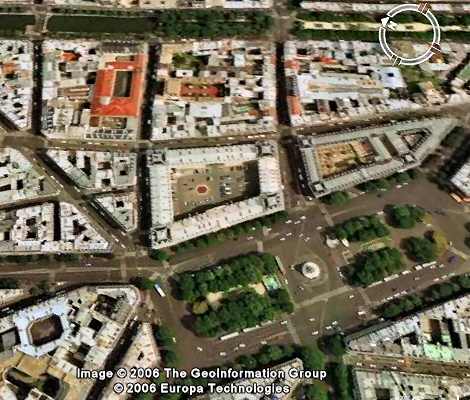
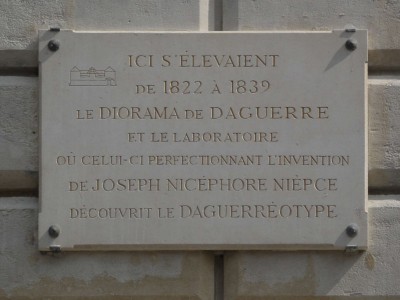
Photographed (July 2001) by R. D. Wood
Commemorating the site of Daguerre’s Diorama:
a plaque fixed high on the north end wall (at
rue Léon Jouhaux) of Caserne Verines.
To the present author, the reference on this plaque to J. N. Nièpce is out of place – but instead, to fairly commemorate the Diorama, Bouton could have been mentioned!
Part 2.1 : The Buildings — London

18 Park Square East, Regents Park, c.1960
The sign ‘Diorama’ had been removed from the pediment
for many years, as at this period, but was later reinstated.
From C. W. Ceram, Archaeology of the Cinema,
Thames and Hudson, London 1965

Aerial view, Park Square East and Peto Place, London, 2001
Showing, in centre, the still existing basic structure of the Diorama
Courtesy of Google Earth and Geoinformation Group
John Timbs in his account of the Diorama in his book, The Curiosities of London, written in 1855, said that the Diorama building “has since been converted into a chapel of the Baptist denomination at the expense of Sir Morton Pete”. It must be this reconstruction of the 1850s (which would have replaced the special arrangement of windows designed for illumination of the dioramas) that has survived until today and features in the above satellite photograph taken in 2001. At the time in the early 1990s when the article on the ‘Diorama in Great Britain’ was written it was used by a local community ‘Diorama Arts centre’, but later 18 Park Square East (which formed the entrance to the Diorama when this Nash terrrace was built in the 1820s) became the national headquarters of a charity ‘The Prince’s Trust’.
Arthur Gill (who throughout the 1960s and 1970s wrote a regular column in The Photographic Journal of the Royal Photographic Society) recorded an account of a visit he made to the Park Square East/ Peto Place building at a time when it was empty in the mid–1970s. He found what seemed to be the remnant of a filled-in well of about twelve feet (3.7 metres) diameter which he thought was originally used to contain the turning shaft on which the Diorama saloon had turned. A few years before, when the building housed a department of the Middlesex Hospital, the well had been filled with warm water and used for hydrotherapy of disabled patients. Mr Gill explored fully the empty building and “tried to imagine what the aspect would be like if the circumferential rooms and offices were absent… However, try as I would, my imagination was unable to sweep away the modern amendments and adaptions, and recapture the Diorama. Except for that concrete–filled well … everything has gone beyond recall”. (Arthur Gill, ‘The London Diorama’, History of Photography, January 1977, Vol. 1, No. 1, pp.31-36)
Part 2.2 : The Buildings — Paris

The Diorama in Paris, Woodcut c.1830
also showing in the background is the
cupola of Charles Langlois’ Panorama building.
From H. & A. Gernsheim, L. J. M. Daguerre, Secker and Warburg: London 1956
|
Diorama Patent | more engravings (3.2) | Home Page | |
Part 3.1 : Dioramas and Paintings

Photographed by R. D. Wood (July 2001)
The diorama painted by Daguerre in 1842 in the church
at Bry-sur-Marne, poorly surviving there after 159 years.
This picture measuring 6 by 5.3 metres has survived in limited form after injuries and several restorations. The image above shows what is seen in 2001 by a casual visitor to the church in the available light, but by controlled lighting it is possible to see this diorama in more of its old glory – as previously [displayed] on a Bry–sur–Marne website devoted to an ‘Expo Daguerre’ held there October to December 2001. The ability to display dioramic effects by lighting from the back and from the front has long been lost. Daguerre had integrated the display with the body and furniture of the church, but the church itself was considerably changed before the first world war as can be glimpsed from a poor reproduction of a photograph from that era in Georges Potonniée’s Daguerre: Peintre et Décorateur (1935), p. 77. It is a precious relic, which Adrien Mentienne, mayor of Bry, and writer on Daguerre (La Découverte de la Photographie en 1839, pp. 108-110) had in 1892 vainly wished could have received the care available in a national museum. However at the beginning of 2007, the news is much better — funds have been obtained (and more sought) to allow restoration of the diorama to begin. The diorama has been carefully removed from the church to a workshop where the restoration is expected to take around three years — go to Daguerre-Bry-sur-Marne website and select ‘Le Diorama de Daguerre’ link at bottom of home page to see more on the first stages of the restoration.
A slide-show presentation on what has been learnt during the restoration work as at January 2009 is provided here on-line.
R. D. Wood’s photographs of Bry-sur-Marne in July 2001, including views of the church, Daguerre’s diorama of 1842 within the church before the restoration, and location of Daguerre’s mansion are also available as a [Slideshow].
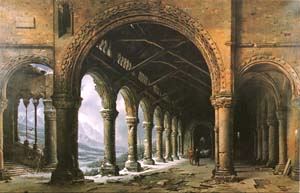
The Effect of Fog and Snow Seen
through a Ruined Gothic Colonnade, 1826
Oil on canvas, L. J. M. Daguerre, in Gerard Levy Collection
Reproduced in Panoramania! by Ralph Hyde,
London: Trefoil Publications / Barbican Art Gallery 1988,
catalogue item No.99 on p.119 with colour illustration on p. 168
Here following are four detail areas from the above image.
You can also chose to see a large [1200 pixel] image of all of Daguerre’s painting.
 |
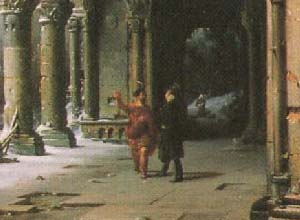 |
 |
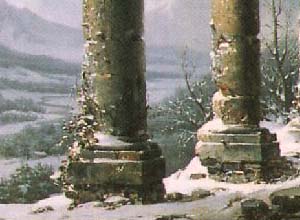 |
Ralph Hyde wrote in the Panoramania! Catalogue about the above painting:
|
Item No.99: Soon after the opening of the Dioramas in Paris and London Daguerre provided three dioramas with Scottish subjects. The first of these, `The Ruins of Holvrood Chapel, Edinburgh, by Moonlight’ was followed by `Roslvn Chapel near Edinburgh, Effect of Sun’, shown in Paris 24 September 2024 to 14 August 2025 and in London from 20 February 1826. The painting here exhibited is based on Daguerre’s third Scottish subject. The Romanesque building is imaginary but one of the two figures wears a kilt. The painting is thoroughly romantic and in spirit corresponds to the work of Caspar David Friedrich and Karl Friedrich Schinkel. It strongly manifests the literary influence of Sir Walter Scott. All is sombre, desolate, and mournful; the long drawn aisles, at first glance, are alone perceived, for a thick fog reigns without, and such is the illusion of the scene that you actually fancy yourself chilled by the cold and damp air. By degrees, however, the fog disperses, and through the vast arches are plainly discovered the forests of pine and larch-trees that cover the valley. The magic of this effect of light is indeed most extraordinary and the illusion is complete and enchanting… Daguerre’s related easel painting after the diorama shows us the scene when the fog has dispersed. That the painting was painted later than the diorama is evidenced by the date on it – 1826. The figure in the picture accompanying the kilted gentleman wears the red emblem of the Legion of Honour, a reference, it would seem, to the artist himself who had the Cross of the Legion bestowed on him by Charles X in January 1826. |
For some more black and white engravings of Daguerre’s dioramas of the 1820s go here to Images [Part 3.2]
|
Diorama Patent | more engravings (3.2) | Home Page | |
Part 4 : Extra Documentation
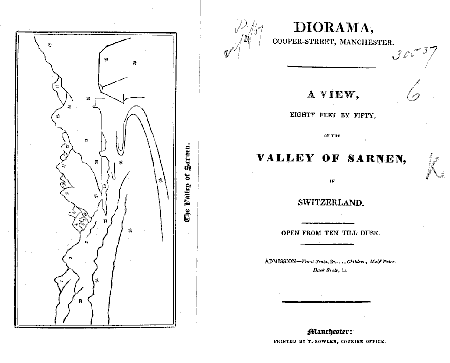
Pamphlet produced by Manchester Diorama in 1825
Courtesy Manchester Central Library

Review in The Times, 4 October 2024
This is the first notice of the recently opened
Diorama in London to appear in The Times.
The second half of the review shown above
deals with Daguerre’s ‘Valley of Sarnen’.
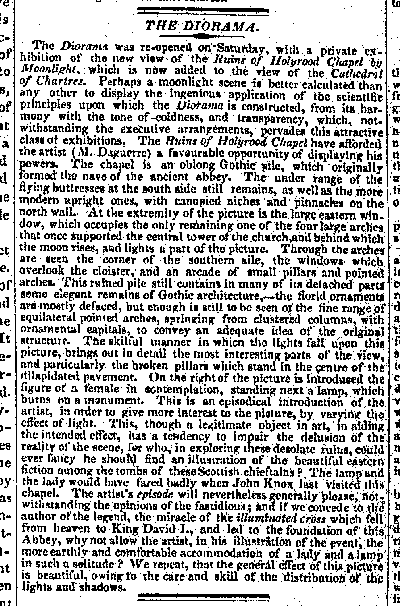
The Diorama: Ruins of Holyrood Chapel
The Times (London), Monday 21 March 1825, p. 2
Part 5.1 : Visiting the Diorama.
Regent’ Park, London
On 4th July 1829 the first horse-drawn Omnibus started in London with a route from Paddington in the west to The Bank in the City of London in the east, going via Regent’s Park and past the Diorama there. A replica (based on a contemporary painting) of that Omnibus was reconstructed 100 years later in 1929 and is displayed at the London Transport Museum in Covent Garden, London.
As can be seen in the illustrations below, the Diorama in Regent’s Park featured prominently on a panel on the side of Shillibeer’s Omnibus, and more information can be found on the informative website of the London Transport Museum at www.ltmuseum.co.uk
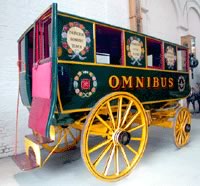
|
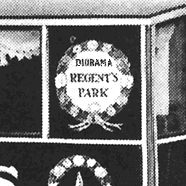
|
|
|
Replica of horse drawn London Omnibus 1829 Route: Paddington – Regent’s Park – Bank Courtesy of London Transport Museum, Covent Garden, London. |
A destination panel on side of Omnibus: “Diorama Regent’s Park” |
Part 5.2 : Visiting the Diorama:
Paris
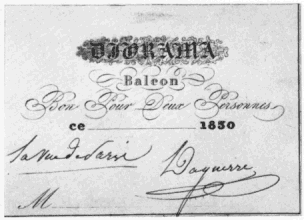
Ticket signed by Daguerre in 1830 for complimentary
visit of two persons to his Diorama in Paris
Reproduced from H. & A. Gernsheim L. J. M. Daguerre,
fig. 26, Secker & Warburg: London 1956
|
Diorama Patent | more engravings (3.2) | Home Page | |
| This document is © copyright R. Derek Wood. Other than for non-commercial and/or scholarly research this document may not be reproduced in any form electronic or otherwise without the written consent of the author. Non-commercial and or scholarly research usage should display the above copyright statement. |
Back to the Top | previous page | Search this site